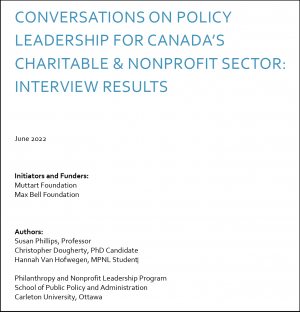 By Susan D. Phillips.
By Susan D. Phillips.
Disruption. Transformation. Reinvention. These lie ahead for Canada’s charitable and nonprofit sector. This sector must drive change for those it serves. And, it must help governments find and implement solutions to a growing number of complex issues. It is not the time for the sector to be passive, reactive or uncoordinated (if it ever was the time). Driving change requires a more powerful, more inclusive, more effective policy presence as the ‘sector’ that has a collective mission to enhance the well-being of all Canadians.
A strong case has been made that a ‘home’ in government – a dedicated Minister, agency or unit – is the route to being taken more seriously in public policy. This is only a partial answer. First, the sector must grow its own infrastructure. It must coordinate and use its collective power: provide an efficient two-way conduit for engagement between governments and the sector’s diverse components; identify shared issues and policy solutions; and amplify, centre and enhance the voices of equity-seeking groups. Without sector-wide coordination, government officials tend to throw up their hands, and claim that there are too many representatives asking for different things, which is (and has been) a sure way for the sector to be ignored.
Stronger policy infrastructure in other countries
Charities in other countries have created stronger policy infrastructure for themselves in recent years. In Australia 19 large national organizations came together to form a Charities Crisis Cabinet in early 2020 to give a policy voice to the sector during the pandemic, and to help charities support their communities, “especially those most vulnerable to increased harm.” The Crisis Cabinet had considerable successes, including a JobKeeper program during COVID, supports for digital transformation, commitment to a national strategy on volunteering and, with a change in government, a federal minister for charities. With an end to the pandemic in sight and a much more positive relationship with government, the Crisis Cabinet disbanded in September 2022.
In the UK, 55 organizations formed the Civil Society Group in November 2021 to increase collaboration and communication among charities, improve relationships with government and ensure better outcomes for communities. The Civil Society Group describes itself as being “an organization that isn’t an organization.” Rather, it harnesses the “collectives strengths of diverse charities” and makes “working together the norm, not just something that happens in times of crisis.” It does not aim to be the sole representative policy voice for the sector or supplant the work of other infrastructure organizations, but instead to amplify and accelerate influence on policy makers. Participation is open to any interested organization and is already quite diverse, which has nevertheless produced agreement on shared priorities.
Why is there so little coordinated action in Canada?
 How might Canada’s charitable sector strengthen its ability to collaborate and affect public policy? With the sense of urgency in this transformational period, the Muttart Foundation and the Max Bell Foundation commissioned my research team to help start conversations about a new cross-sector leadership vehicle. We produced a background paper on cross-sector leadership models and conducted interviews (N= 41) with a wide range of sector leaders, summarized as a second report.
How might Canada’s charitable sector strengthen its ability to collaborate and affect public policy? With the sense of urgency in this transformational period, the Muttart Foundation and the Max Bell Foundation commissioned my research team to help start conversations about a new cross-sector leadership vehicle. We produced a background paper on cross-sector leadership models and conducted interviews (N= 41) with a wide range of sector leaders, summarized as a second report.
There was general consensus among interviewees that leadership across the sector could be strengthened, although there are differing assessments of how best to do this. There is no appetite for a new organization, as a formal incorporated entity, that would take the place of existing infrastructure organizations. Rather, three potential structures – all of which would provide meaningful engagement with justice and equity-seeking groups – were identified:
- A coalition/network that works as a ‘network of networks’ to bring together existing organizations across subsectors, including equity-seeking groups, and that collectively advocates on cross-sector issues;
- A policy advocacy shop that is a small, purpose-built entity focused solely on advancing policy engagement for the sector, mainly at the federal level; and
- A participatory forum that first aims to deepen understanding of the issues within the sector through meaningful, inclusive dialogue, and then gets these perspectives reflected in advocacy work being done on behalf of the sector.
We heard that how a new mechanism is formed, and who leads the process, will affect its legitimacy and the willingness of others to come on board. There was a clear sense that the catalyst should not be a single organization, as this does not instill confidence that the new mechanism would not be controlled by it (whether by design or inadvertently).
Banner photo of Parliament is courtesy of Shubham Sharan.
Wednesday, November 9, 2022 in Leadership & Governance, News & Events, Public Policy & Advocacy
Share: Twitter, Facebook



